Operations and Project Management Report: Toyota, PLC, and Improvement
VerifiedAdded on 2023/01/09
|25
|6460
|51
Report
AI Summary
This report delves into the realms of operations and project management, using Toyota Motor Corporation as a central case study. It begins by outlining the core objectives and principles of operations management, highlighting their practical application within Toyota. The report then explores Toyota's approach to continuous improvement, examining the implementation of Six Sigma and Lean Production methodologies. Furthermore, it investigates the project life cycle (PLC) in the context of expanding a business, such as a Leisure Centre, including the application of various project management tools like WBS, Gantt charts, and the Critical Path method. The analysis extends to evaluating the effectiveness of these tools in both large and small-scale projects, providing a comprehensive overview of how these management concepts are utilized to enhance efficiency, reduce costs, and improve product quality. The report aims to provide a clear understanding of the effective management of operations and projects, which are crucial for achieving competitive advantage in the market.
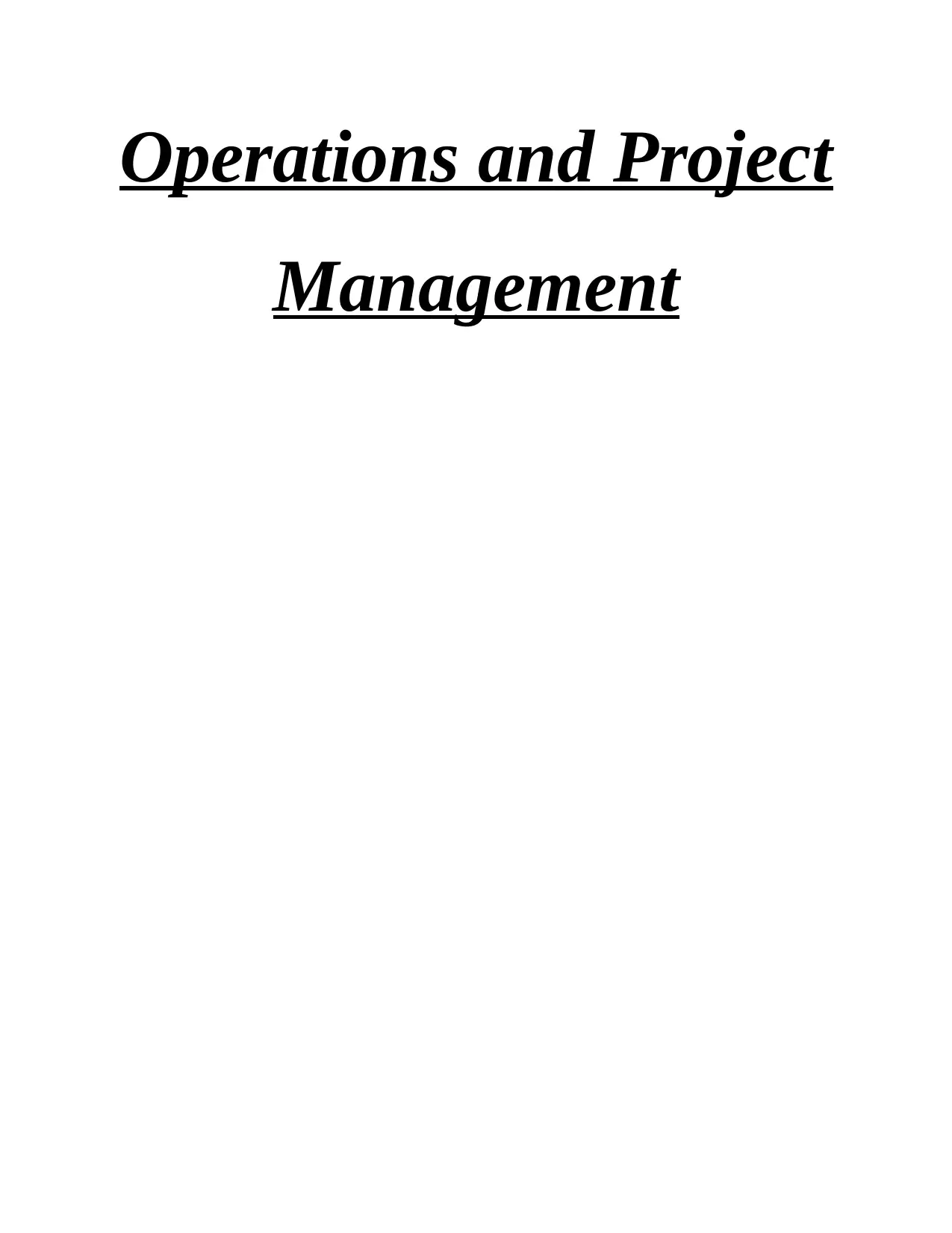
Operations and Project
Management
Management
Paraphrase This Document
Need a fresh take? Get an instant paraphrase of this document with our AI Paraphraser
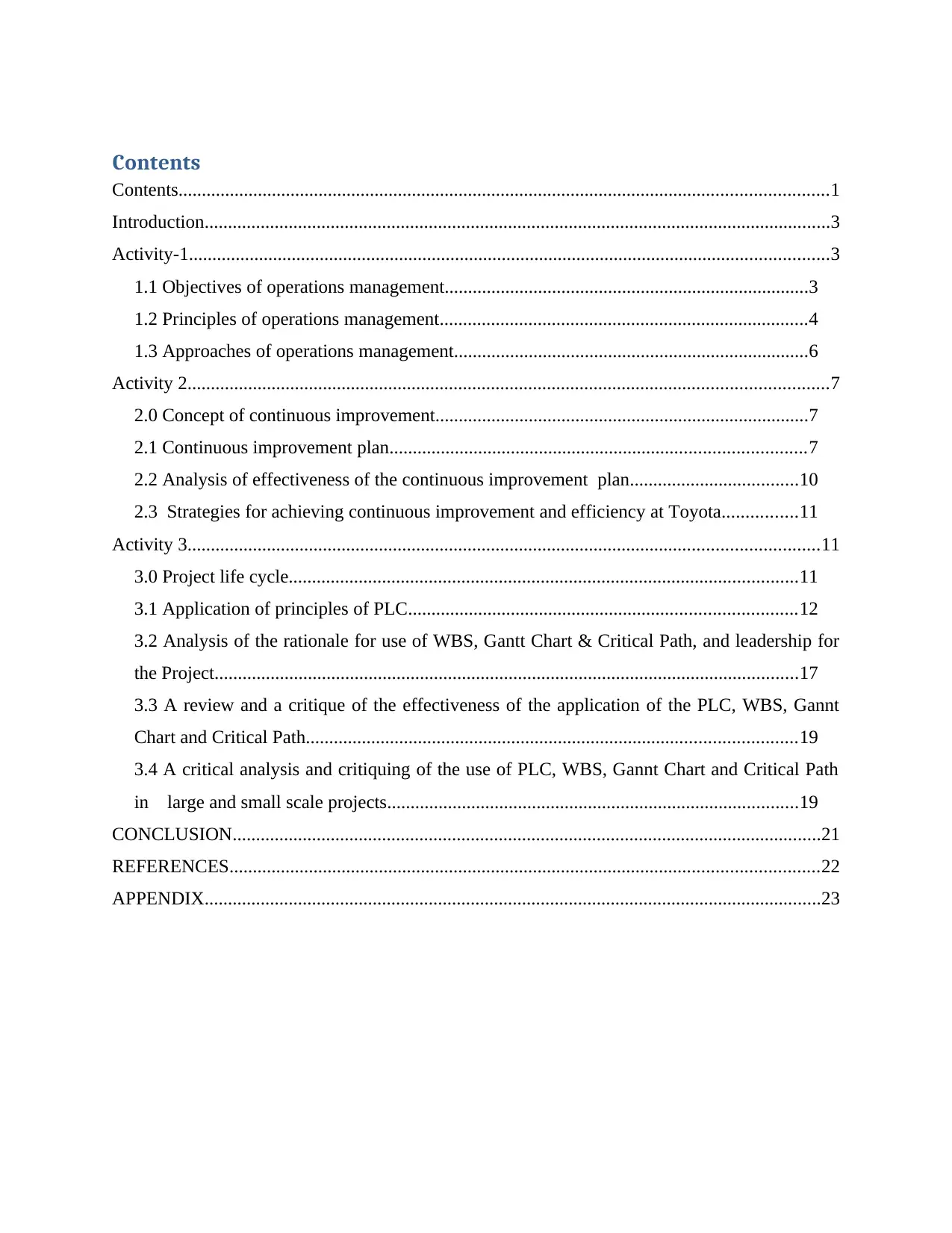
Contents
Contents...........................................................................................................................................1
Introduction......................................................................................................................................3
Activity-1.........................................................................................................................................3
1.1 Objectives of operations management..............................................................................3
1.2 Principles of operations management...............................................................................4
1.3 Approaches of operations management............................................................................6
Activity 2.........................................................................................................................................7
2.0 Concept of continuous improvement................................................................................7
2.1 Continuous improvement plan.........................................................................................7
2.2 Analysis of effectiveness of the continuous improvement plan....................................10
2.3 Strategies for achieving continuous improvement and efficiency at Toyota................11
Activity 3.......................................................................................................................................11
3.0 Project life cycle.............................................................................................................11
3.1 Application of principles of PLC...................................................................................12
3.2 Analysis of the rationale for use of WBS, Gantt Chart & Critical Path, and leadership for
the Project.............................................................................................................................17
3.3 A review and a critique of the effectiveness of the application of the PLC, WBS, Gannt
Chart and Critical Path.........................................................................................................19
3.4 A critical analysis and critiquing of the use of PLC, WBS, Gannt Chart and Critical Path
in large and small scale projects........................................................................................19
CONCLUSION..............................................................................................................................21
REFERENCES..............................................................................................................................22
APPENDIX....................................................................................................................................23
Contents...........................................................................................................................................1
Introduction......................................................................................................................................3
Activity-1.........................................................................................................................................3
1.1 Objectives of operations management..............................................................................3
1.2 Principles of operations management...............................................................................4
1.3 Approaches of operations management............................................................................6
Activity 2.........................................................................................................................................7
2.0 Concept of continuous improvement................................................................................7
2.1 Continuous improvement plan.........................................................................................7
2.2 Analysis of effectiveness of the continuous improvement plan....................................10
2.3 Strategies for achieving continuous improvement and efficiency at Toyota................11
Activity 3.......................................................................................................................................11
3.0 Project life cycle.............................................................................................................11
3.1 Application of principles of PLC...................................................................................12
3.2 Analysis of the rationale for use of WBS, Gantt Chart & Critical Path, and leadership for
the Project.............................................................................................................................17
3.3 A review and a critique of the effectiveness of the application of the PLC, WBS, Gannt
Chart and Critical Path.........................................................................................................19
3.4 A critical analysis and critiquing of the use of PLC, WBS, Gannt Chart and Critical Path
in large and small scale projects........................................................................................19
CONCLUSION..............................................................................................................................21
REFERENCES..............................................................................................................................22
APPENDIX....................................................................................................................................23
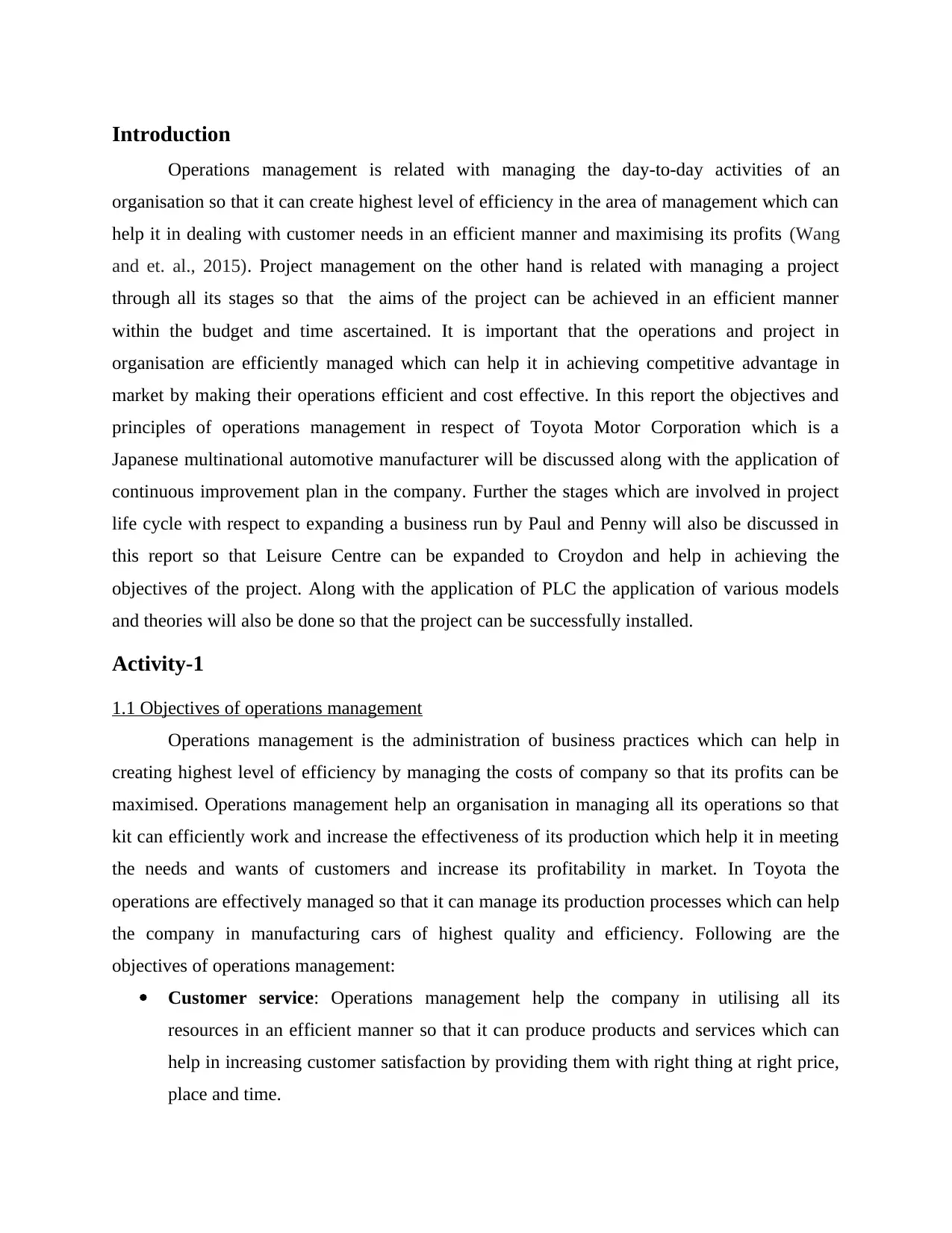
Introduction
Operations management is related with managing the day-to-day activities of an
organisation so that it can create highest level of efficiency in the area of management which can
help it in dealing with customer needs in an efficient manner and maximising its profits (Wang
and et. al., 2015). Project management on the other hand is related with managing a project
through all its stages so that the aims of the project can be achieved in an efficient manner
within the budget and time ascertained. It is important that the operations and project in
organisation are efficiently managed which can help it in achieving competitive advantage in
market by making their operations efficient and cost effective. In this report the objectives and
principles of operations management in respect of Toyota Motor Corporation which is a
Japanese multinational automotive manufacturer will be discussed along with the application of
continuous improvement plan in the company. Further the stages which are involved in project
life cycle with respect to expanding a business run by Paul and Penny will also be discussed in
this report so that Leisure Centre can be expanded to Croydon and help in achieving the
objectives of the project. Along with the application of PLC the application of various models
and theories will also be done so that the project can be successfully installed.
Activity-1
1.1 Objectives of operations management
Operations management is the administration of business practices which can help in
creating highest level of efficiency by managing the costs of company so that its profits can be
maximised. Operations management help an organisation in managing all its operations so that
kit can efficiently work and increase the effectiveness of its production which help it in meeting
the needs and wants of customers and increase its profitability in market. In Toyota the
operations are effectively managed so that it can manage its production processes which can help
the company in manufacturing cars of highest quality and efficiency. Following are the
objectives of operations management:
Customer service: Operations management help the company in utilising all its
resources in an efficient manner so that it can produce products and services which can
help in increasing customer satisfaction by providing them with right thing at right price,
place and time.
Operations management is related with managing the day-to-day activities of an
organisation so that it can create highest level of efficiency in the area of management which can
help it in dealing with customer needs in an efficient manner and maximising its profits (Wang
and et. al., 2015). Project management on the other hand is related with managing a project
through all its stages so that the aims of the project can be achieved in an efficient manner
within the budget and time ascertained. It is important that the operations and project in
organisation are efficiently managed which can help it in achieving competitive advantage in
market by making their operations efficient and cost effective. In this report the objectives and
principles of operations management in respect of Toyota Motor Corporation which is a
Japanese multinational automotive manufacturer will be discussed along with the application of
continuous improvement plan in the company. Further the stages which are involved in project
life cycle with respect to expanding a business run by Paul and Penny will also be discussed in
this report so that Leisure Centre can be expanded to Croydon and help in achieving the
objectives of the project. Along with the application of PLC the application of various models
and theories will also be done so that the project can be successfully installed.
Activity-1
1.1 Objectives of operations management
Operations management is the administration of business practices which can help in
creating highest level of efficiency by managing the costs of company so that its profits can be
maximised. Operations management help an organisation in managing all its operations so that
kit can efficiently work and increase the effectiveness of its production which help it in meeting
the needs and wants of customers and increase its profitability in market. In Toyota the
operations are effectively managed so that it can manage its production processes which can help
the company in manufacturing cars of highest quality and efficiency. Following are the
objectives of operations management:
Customer service: Operations management help the company in utilising all its
resources in an efficient manner so that it can produce products and services which can
help in increasing customer satisfaction by providing them with right thing at right price,
place and time.
⊘ This is a preview!⊘
Do you want full access?
Subscribe today to unlock all pages.

Trusted by 1+ million students worldwide
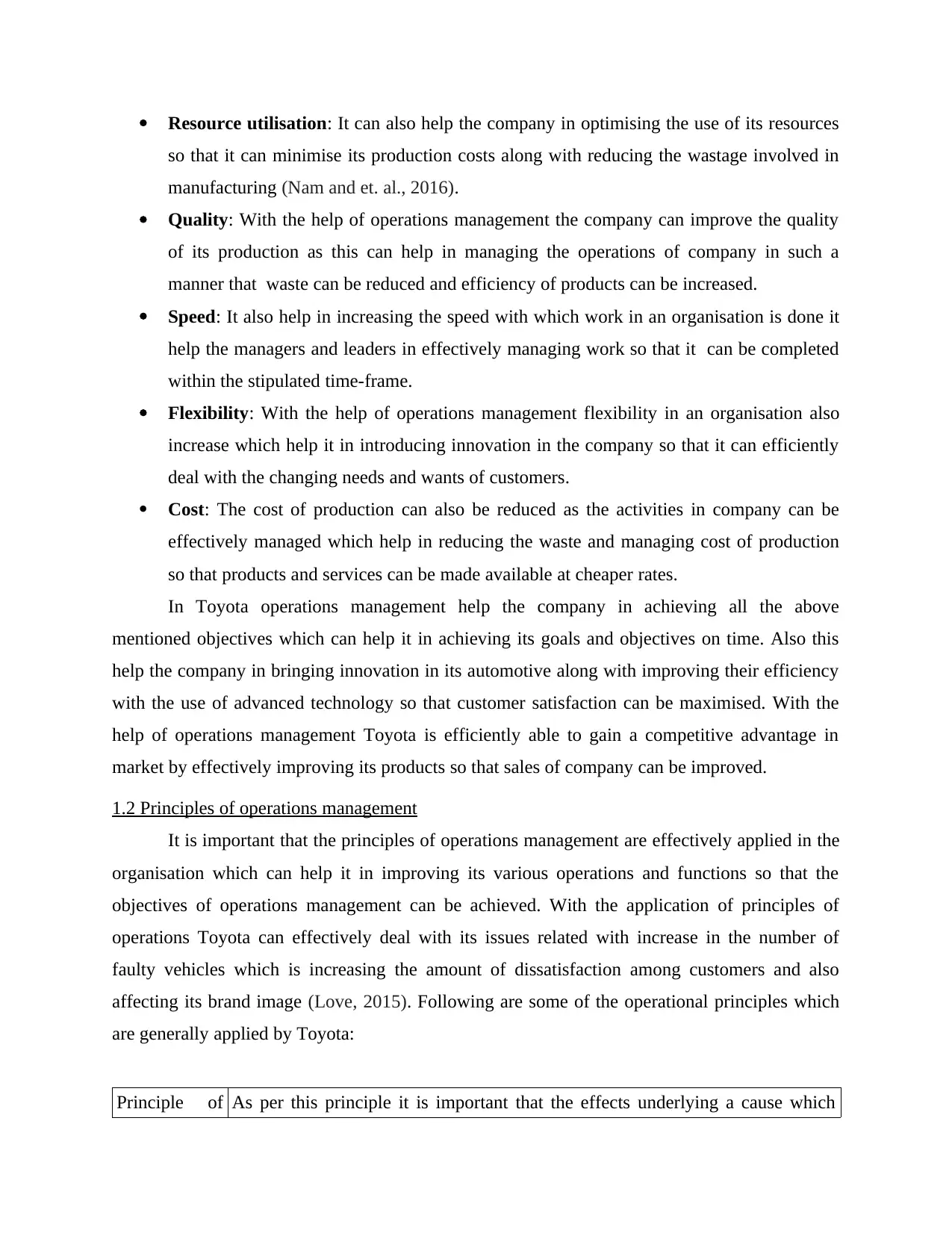
Resource utilisation: It can also help the company in optimising the use of its resources
so that it can minimise its production costs along with reducing the wastage involved in
manufacturing (Nam and et. al., 2016).
Quality: With the help of operations management the company can improve the quality
of its production as this can help in managing the operations of company in such a
manner that waste can be reduced and efficiency of products can be increased.
Speed: It also help in increasing the speed with which work in an organisation is done it
help the managers and leaders in effectively managing work so that it can be completed
within the stipulated time-frame.
Flexibility: With the help of operations management flexibility in an organisation also
increase which help it in introducing innovation in the company so that it can efficiently
deal with the changing needs and wants of customers.
Cost: The cost of production can also be reduced as the activities in company can be
effectively managed which help in reducing the waste and managing cost of production
so that products and services can be made available at cheaper rates.
In Toyota operations management help the company in achieving all the above
mentioned objectives which can help it in achieving its goals and objectives on time. Also this
help the company in bringing innovation in its automotive along with improving their efficiency
with the use of advanced technology so that customer satisfaction can be maximised. With the
help of operations management Toyota is efficiently able to gain a competitive advantage in
market by effectively improving its products so that sales of company can be improved.
1.2 Principles of operations management
It is important that the principles of operations management are effectively applied in the
organisation which can help it in improving its various operations and functions so that the
objectives of operations management can be achieved. With the application of principles of
operations Toyota can effectively deal with its issues related with increase in the number of
faulty vehicles which is increasing the amount of dissatisfaction among customers and also
affecting its brand image (Love, 2015). Following are some of the operational principles which
are generally applied by Toyota:
Principle of As per this principle it is important that the effects underlying a cause which
so that it can minimise its production costs along with reducing the wastage involved in
manufacturing (Nam and et. al., 2016).
Quality: With the help of operations management the company can improve the quality
of its production as this can help in managing the operations of company in such a
manner that waste can be reduced and efficiency of products can be increased.
Speed: It also help in increasing the speed with which work in an organisation is done it
help the managers and leaders in effectively managing work so that it can be completed
within the stipulated time-frame.
Flexibility: With the help of operations management flexibility in an organisation also
increase which help it in introducing innovation in the company so that it can efficiently
deal with the changing needs and wants of customers.
Cost: The cost of production can also be reduced as the activities in company can be
effectively managed which help in reducing the waste and managing cost of production
so that products and services can be made available at cheaper rates.
In Toyota operations management help the company in achieving all the above
mentioned objectives which can help it in achieving its goals and objectives on time. Also this
help the company in bringing innovation in its automotive along with improving their efficiency
with the use of advanced technology so that customer satisfaction can be maximised. With the
help of operations management Toyota is efficiently able to gain a competitive advantage in
market by effectively improving its products so that sales of company can be improved.
1.2 Principles of operations management
It is important that the principles of operations management are effectively applied in the
organisation which can help it in improving its various operations and functions so that the
objectives of operations management can be achieved. With the application of principles of
operations Toyota can effectively deal with its issues related with increase in the number of
faulty vehicles which is increasing the amount of dissatisfaction among customers and also
affecting its brand image (Love, 2015). Following are some of the operational principles which
are generally applied by Toyota:
Principle of As per this principle it is important that the effects underlying a cause which
Paraphrase This Document
Need a fresh take? Get an instant paraphrase of this document with our AI Paraphraser
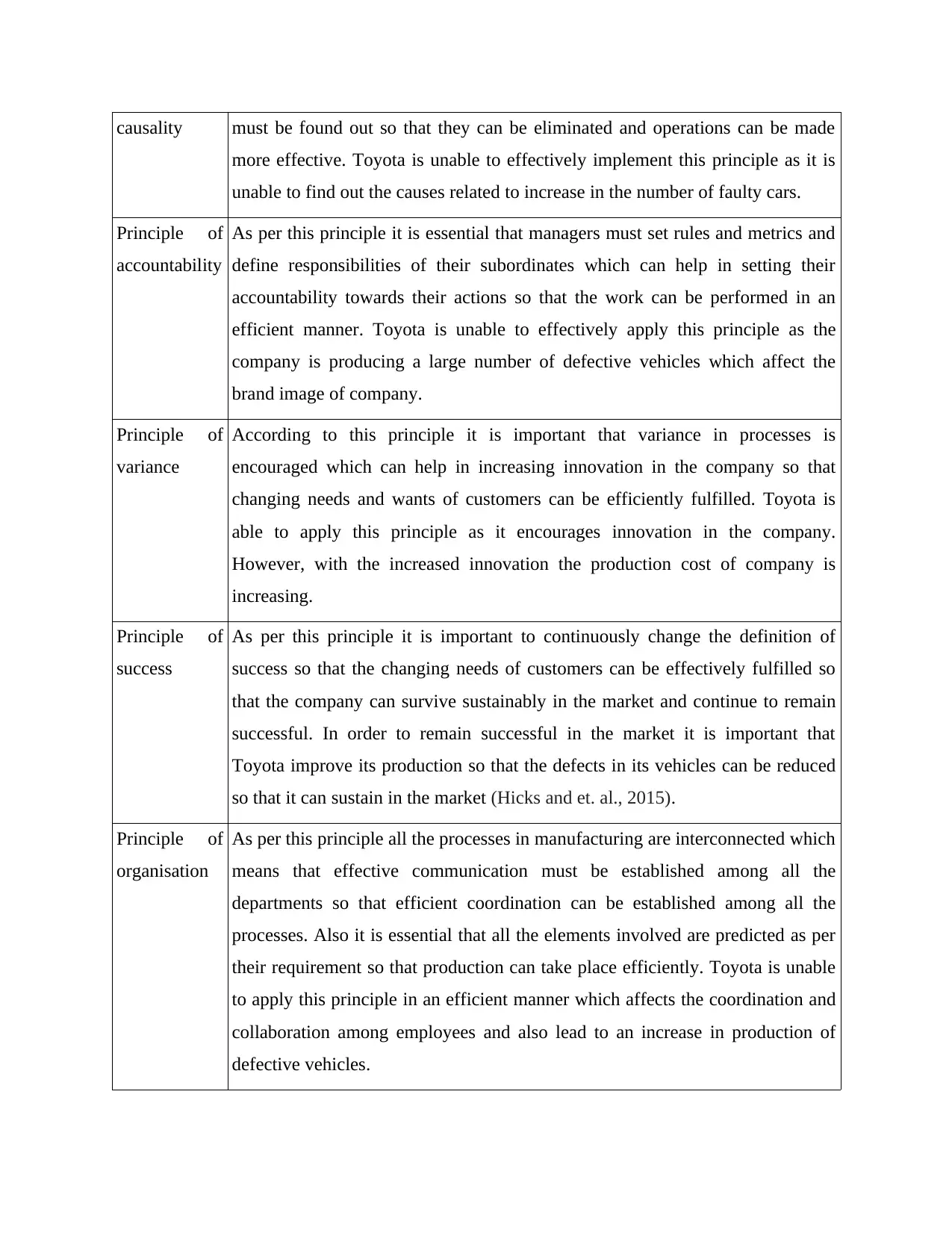
causality must be found out so that they can be eliminated and operations can be made
more effective. Toyota is unable to effectively implement this principle as it is
unable to find out the causes related to increase in the number of faulty cars.
Principle of
accountability
As per this principle it is essential that managers must set rules and metrics and
define responsibilities of their subordinates which can help in setting their
accountability towards their actions so that the work can be performed in an
efficient manner. Toyota is unable to effectively apply this principle as the
company is producing a large number of defective vehicles which affect the
brand image of company.
Principle of
variance
According to this principle it is important that variance in processes is
encouraged which can help in increasing innovation in the company so that
changing needs and wants of customers can be efficiently fulfilled. Toyota is
able to apply this principle as it encourages innovation in the company.
However, with the increased innovation the production cost of company is
increasing.
Principle of
success
As per this principle it is important to continuously change the definition of
success so that the changing needs of customers can be effectively fulfilled so
that the company can survive sustainably in the market and continue to remain
successful. In order to remain successful in the market it is important that
Toyota improve its production so that the defects in its vehicles can be reduced
so that it can sustain in the market (Hicks and et. al., 2015).
Principle of
organisation
As per this principle all the processes in manufacturing are interconnected which
means that effective communication must be established among all the
departments so that efficient coordination can be established among all the
processes. Also it is essential that all the elements involved are predicted as per
their requirement so that production can take place efficiently. Toyota is unable
to apply this principle in an efficient manner which affects the coordination and
collaboration among employees and also lead to an increase in production of
defective vehicles.
more effective. Toyota is unable to effectively implement this principle as it is
unable to find out the causes related to increase in the number of faulty cars.
Principle of
accountability
As per this principle it is essential that managers must set rules and metrics and
define responsibilities of their subordinates which can help in setting their
accountability towards their actions so that the work can be performed in an
efficient manner. Toyota is unable to effectively apply this principle as the
company is producing a large number of defective vehicles which affect the
brand image of company.
Principle of
variance
According to this principle it is important that variance in processes is
encouraged which can help in increasing innovation in the company so that
changing needs and wants of customers can be efficiently fulfilled. Toyota is
able to apply this principle as it encourages innovation in the company.
However, with the increased innovation the production cost of company is
increasing.
Principle of
success
As per this principle it is important to continuously change the definition of
success so that the changing needs of customers can be effectively fulfilled so
that the company can survive sustainably in the market and continue to remain
successful. In order to remain successful in the market it is important that
Toyota improve its production so that the defects in its vehicles can be reduced
so that it can sustain in the market (Hicks and et. al., 2015).
Principle of
organisation
As per this principle all the processes in manufacturing are interconnected which
means that effective communication must be established among all the
departments so that efficient coordination can be established among all the
processes. Also it is essential that all the elements involved are predicted as per
their requirement so that production can take place efficiently. Toyota is unable
to apply this principle in an efficient manner which affects the coordination and
collaboration among employees and also lead to an increase in production of
defective vehicles.
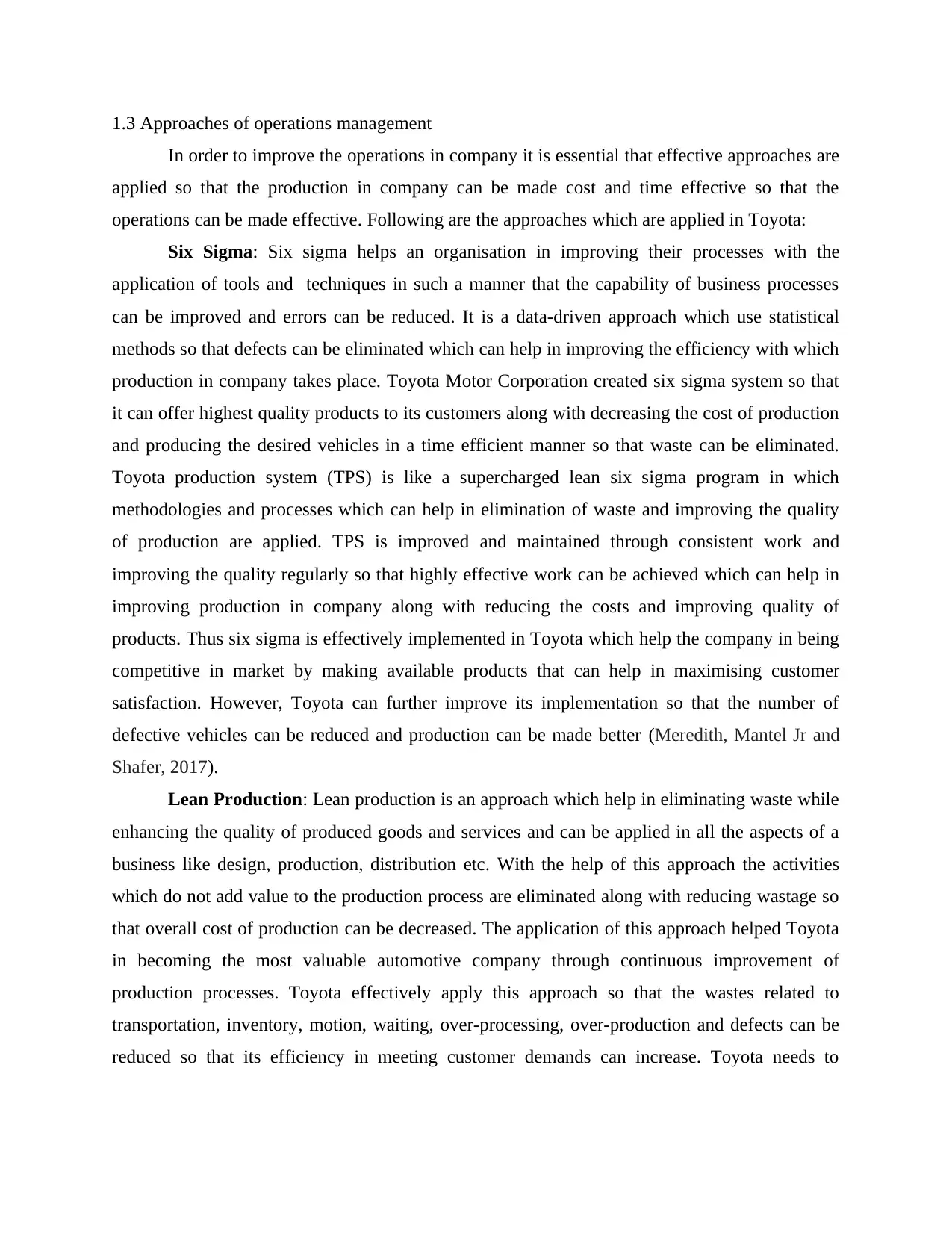
1.3 Approaches of operations management
In order to improve the operations in company it is essential that effective approaches are
applied so that the production in company can be made cost and time effective so that the
operations can be made effective. Following are the approaches which are applied in Toyota:
Six Sigma: Six sigma helps an organisation in improving their processes with the
application of tools and techniques in such a manner that the capability of business processes
can be improved and errors can be reduced. It is a data-driven approach which use statistical
methods so that defects can be eliminated which can help in improving the efficiency with which
production in company takes place. Toyota Motor Corporation created six sigma system so that
it can offer highest quality products to its customers along with decreasing the cost of production
and producing the desired vehicles in a time efficient manner so that waste can be eliminated.
Toyota production system (TPS) is like a supercharged lean six sigma program in which
methodologies and processes which can help in elimination of waste and improving the quality
of production are applied. TPS is improved and maintained through consistent work and
improving the quality regularly so that highly effective work can be achieved which can help in
improving production in company along with reducing the costs and improving quality of
products. Thus six sigma is effectively implemented in Toyota which help the company in being
competitive in market by making available products that can help in maximising customer
satisfaction. However, Toyota can further improve its implementation so that the number of
defective vehicles can be reduced and production can be made better (Meredith, Mantel Jr and
Shafer, 2017).
Lean Production: Lean production is an approach which help in eliminating waste while
enhancing the quality of produced goods and services and can be applied in all the aspects of a
business like design, production, distribution etc. With the help of this approach the activities
which do not add value to the production process are eliminated along with reducing wastage so
that overall cost of production can be decreased. The application of this approach helped Toyota
in becoming the most valuable automotive company through continuous improvement of
production processes. Toyota effectively apply this approach so that the wastes related to
transportation, inventory, motion, waiting, over-processing, over-production and defects can be
reduced so that its efficiency in meeting customer demands can increase. Toyota needs to
In order to improve the operations in company it is essential that effective approaches are
applied so that the production in company can be made cost and time effective so that the
operations can be made effective. Following are the approaches which are applied in Toyota:
Six Sigma: Six sigma helps an organisation in improving their processes with the
application of tools and techniques in such a manner that the capability of business processes
can be improved and errors can be reduced. It is a data-driven approach which use statistical
methods so that defects can be eliminated which can help in improving the efficiency with which
production in company takes place. Toyota Motor Corporation created six sigma system so that
it can offer highest quality products to its customers along with decreasing the cost of production
and producing the desired vehicles in a time efficient manner so that waste can be eliminated.
Toyota production system (TPS) is like a supercharged lean six sigma program in which
methodologies and processes which can help in elimination of waste and improving the quality
of production are applied. TPS is improved and maintained through consistent work and
improving the quality regularly so that highly effective work can be achieved which can help in
improving production in company along with reducing the costs and improving quality of
products. Thus six sigma is effectively implemented in Toyota which help the company in being
competitive in market by making available products that can help in maximising customer
satisfaction. However, Toyota can further improve its implementation so that the number of
defective vehicles can be reduced and production can be made better (Meredith, Mantel Jr and
Shafer, 2017).
Lean Production: Lean production is an approach which help in eliminating waste while
enhancing the quality of produced goods and services and can be applied in all the aspects of a
business like design, production, distribution etc. With the help of this approach the activities
which do not add value to the production process are eliminated along with reducing wastage so
that overall cost of production can be decreased. The application of this approach helped Toyota
in becoming the most valuable automotive company through continuous improvement of
production processes. Toyota effectively apply this approach so that the wastes related to
transportation, inventory, motion, waiting, over-processing, over-production and defects can be
reduced so that its efficiency in meeting customer demands can increase. Toyota needs to
⊘ This is a preview!⊘
Do you want full access?
Subscribe today to unlock all pages.

Trusted by 1+ million students worldwide
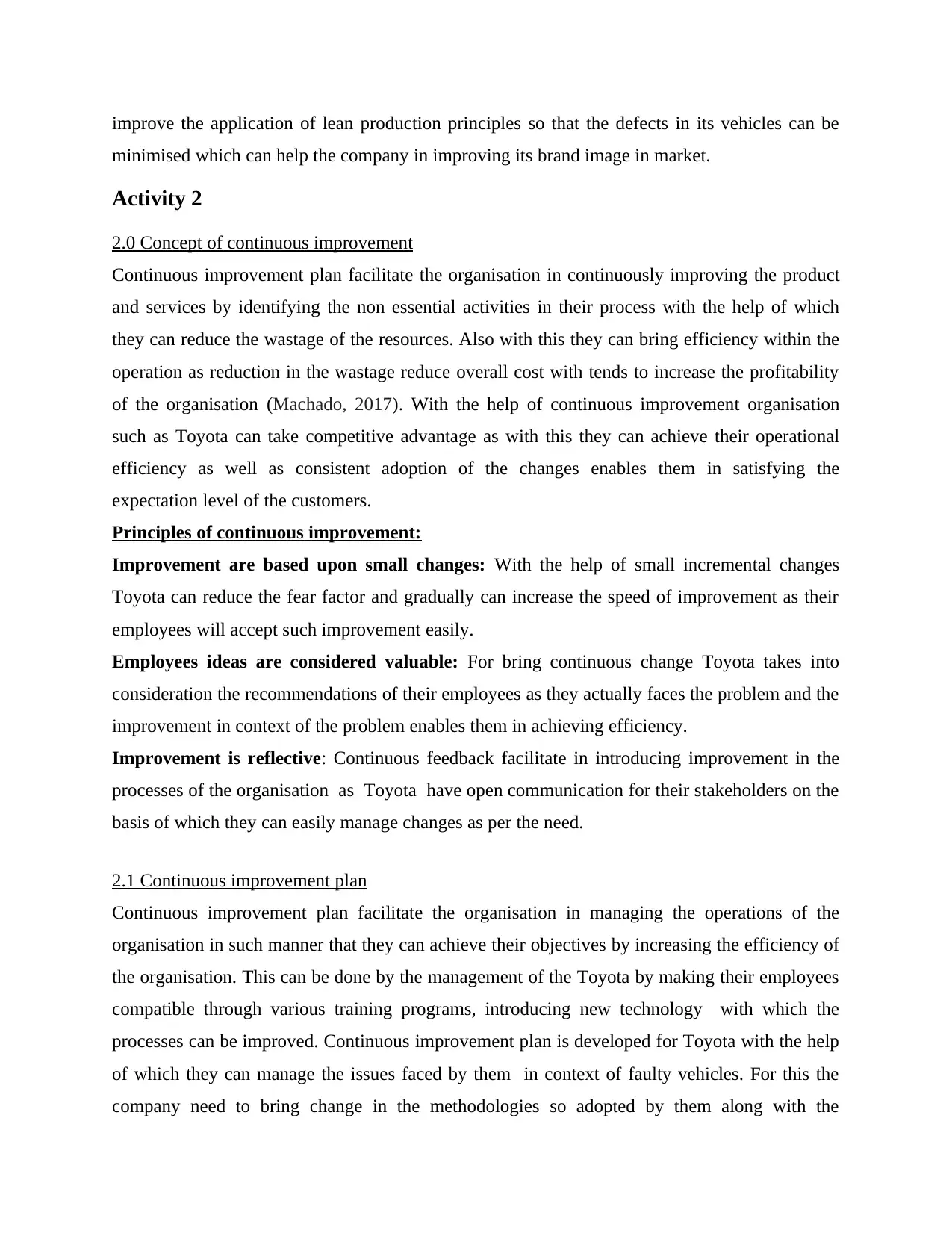
improve the application of lean production principles so that the defects in its vehicles can be
minimised which can help the company in improving its brand image in market.
Activity 2
2.0 Concept of continuous improvement
Continuous improvement plan facilitate the organisation in continuously improving the product
and services by identifying the non essential activities in their process with the help of which
they can reduce the wastage of the resources. Also with this they can bring efficiency within the
operation as reduction in the wastage reduce overall cost with tends to increase the profitability
of the organisation (Machado, 2017). With the help of continuous improvement organisation
such as Toyota can take competitive advantage as with this they can achieve their operational
efficiency as well as consistent adoption of the changes enables them in satisfying the
expectation level of the customers.
Principles of continuous improvement:
Improvement are based upon small changes: With the help of small incremental changes
Toyota can reduce the fear factor and gradually can increase the speed of improvement as their
employees will accept such improvement easily.
Employees ideas are considered valuable: For bring continuous change Toyota takes into
consideration the recommendations of their employees as they actually faces the problem and the
improvement in context of the problem enables them in achieving efficiency.
Improvement is reflective: Continuous feedback facilitate in introducing improvement in the
processes of the organisation as Toyota have open communication for their stakeholders on the
basis of which they can easily manage changes as per the need.
2.1 Continuous improvement plan
Continuous improvement plan facilitate the organisation in managing the operations of the
organisation in such manner that they can achieve their objectives by increasing the efficiency of
the organisation. This can be done by the management of the Toyota by making their employees
compatible through various training programs, introducing new technology with which the
processes can be improved. Continuous improvement plan is developed for Toyota with the help
of which they can manage the issues faced by them in context of faulty vehicles. For this the
company need to bring change in the methodologies so adopted by them along with the
minimised which can help the company in improving its brand image in market.
Activity 2
2.0 Concept of continuous improvement
Continuous improvement plan facilitate the organisation in continuously improving the product
and services by identifying the non essential activities in their process with the help of which
they can reduce the wastage of the resources. Also with this they can bring efficiency within the
operation as reduction in the wastage reduce overall cost with tends to increase the profitability
of the organisation (Machado, 2017). With the help of continuous improvement organisation
such as Toyota can take competitive advantage as with this they can achieve their operational
efficiency as well as consistent adoption of the changes enables them in satisfying the
expectation level of the customers.
Principles of continuous improvement:
Improvement are based upon small changes: With the help of small incremental changes
Toyota can reduce the fear factor and gradually can increase the speed of improvement as their
employees will accept such improvement easily.
Employees ideas are considered valuable: For bring continuous change Toyota takes into
consideration the recommendations of their employees as they actually faces the problem and the
improvement in context of the problem enables them in achieving efficiency.
Improvement is reflective: Continuous feedback facilitate in introducing improvement in the
processes of the organisation as Toyota have open communication for their stakeholders on the
basis of which they can easily manage changes as per the need.
2.1 Continuous improvement plan
Continuous improvement plan facilitate the organisation in managing the operations of the
organisation in such manner that they can achieve their objectives by increasing the efficiency of
the organisation. This can be done by the management of the Toyota by making their employees
compatible through various training programs, introducing new technology with which the
processes can be improved. Continuous improvement plan is developed for Toyota with the help
of which they can manage the issues faced by them in context of faulty vehicles. For this the
company need to bring change in the methodologies so adopted by them along with the
Paraphrase This Document
Need a fresh take? Get an instant paraphrase of this document with our AI Paraphraser
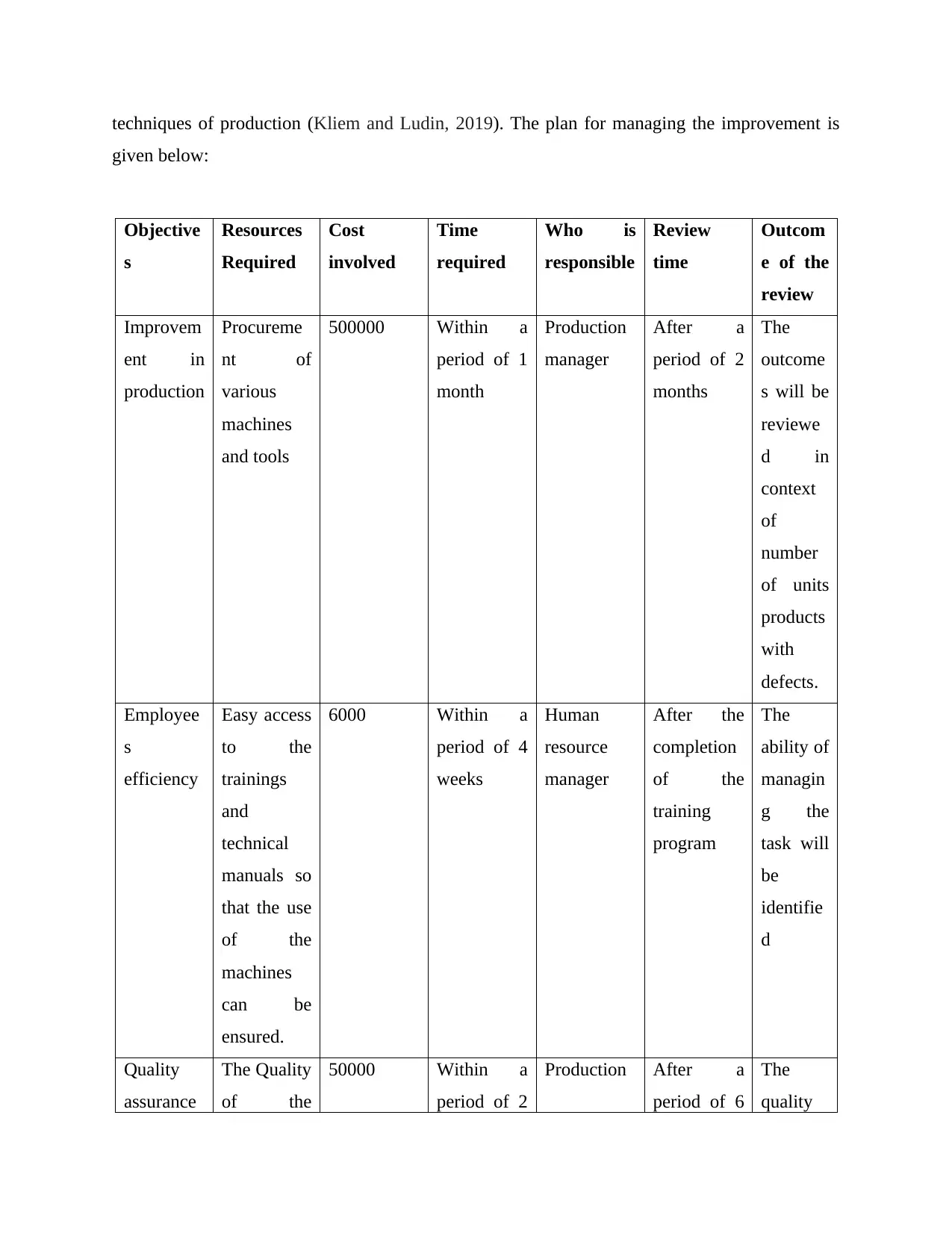
techniques of production (Kliem and Ludin, 2019). The plan for managing the improvement is
given below:
Objective
s
Resources
Required
Cost
involved
Time
required
Who is
responsible
Review
time
Outcom
e of the
review
Improvem
ent in
production
Procureme
nt of
various
machines
and tools
500000 Within a
period of 1
month
Production
manager
After a
period of 2
months
The
outcome
s will be
reviewe
d in
context
of
number
of units
products
with
defects.
Employee
s
efficiency
Easy access
to the
trainings
and
technical
manuals so
that the use
of the
machines
can be
ensured.
6000 Within a
period of 4
weeks
Human
resource
manager
After the
completion
of the
training
program
The
ability of
managin
g the
task will
be
identifie
d
Quality
assurance
The Quality
of the
50000 Within a
period of 2
Production After a
period of 6
The
quality
given below:
Objective
s
Resources
Required
Cost
involved
Time
required
Who is
responsible
Review
time
Outcom
e of the
review
Improvem
ent in
production
Procureme
nt of
various
machines
and tools
500000 Within a
period of 1
month
Production
manager
After a
period of 2
months
The
outcome
s will be
reviewe
d in
context
of
number
of units
products
with
defects.
Employee
s
efficiency
Easy access
to the
trainings
and
technical
manuals so
that the use
of the
machines
can be
ensured.
6000 Within a
period of 4
weeks
Human
resource
manager
After the
completion
of the
training
program
The
ability of
managin
g the
task will
be
identifie
d
Quality
assurance
The Quality
of the
50000 Within a
period of 2
Production After a
period of 6
The
quality
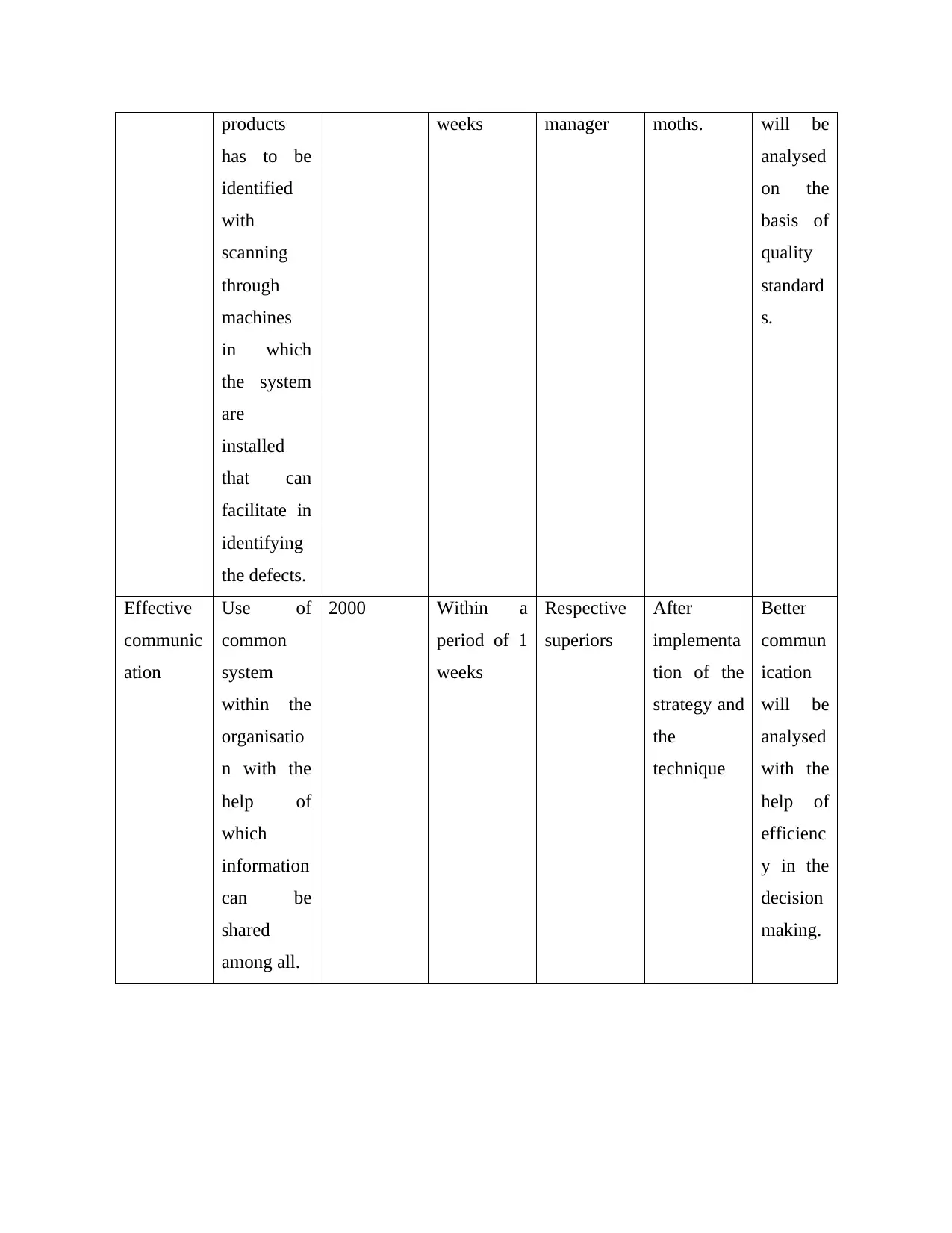
products
has to be
identified
with
scanning
through
machines
in which
the system
are
installed
that can
facilitate in
identifying
the defects.
weeks manager moths. will be
analysed
on the
basis of
quality
standard
s.
Effective
communic
ation
Use of
common
system
within the
organisatio
n with the
help of
which
information
can be
shared
among all.
2000 Within a
period of 1
weeks
Respective
superiors
After
implementa
tion of the
strategy and
the
technique
Better
commun
ication
will be
analysed
with the
help of
efficienc
y in the
decision
making.
has to be
identified
with
scanning
through
machines
in which
the system
are
installed
that can
facilitate in
identifying
the defects.
weeks manager moths. will be
analysed
on the
basis of
quality
standard
s.
Effective
communic
ation
Use of
common
system
within the
organisatio
n with the
help of
which
information
can be
shared
among all.
2000 Within a
period of 1
weeks
Respective
superiors
After
implementa
tion of the
strategy and
the
technique
Better
commun
ication
will be
analysed
with the
help of
efficienc
y in the
decision
making.
⊘ This is a preview!⊘
Do you want full access?
Subscribe today to unlock all pages.

Trusted by 1+ million students worldwide
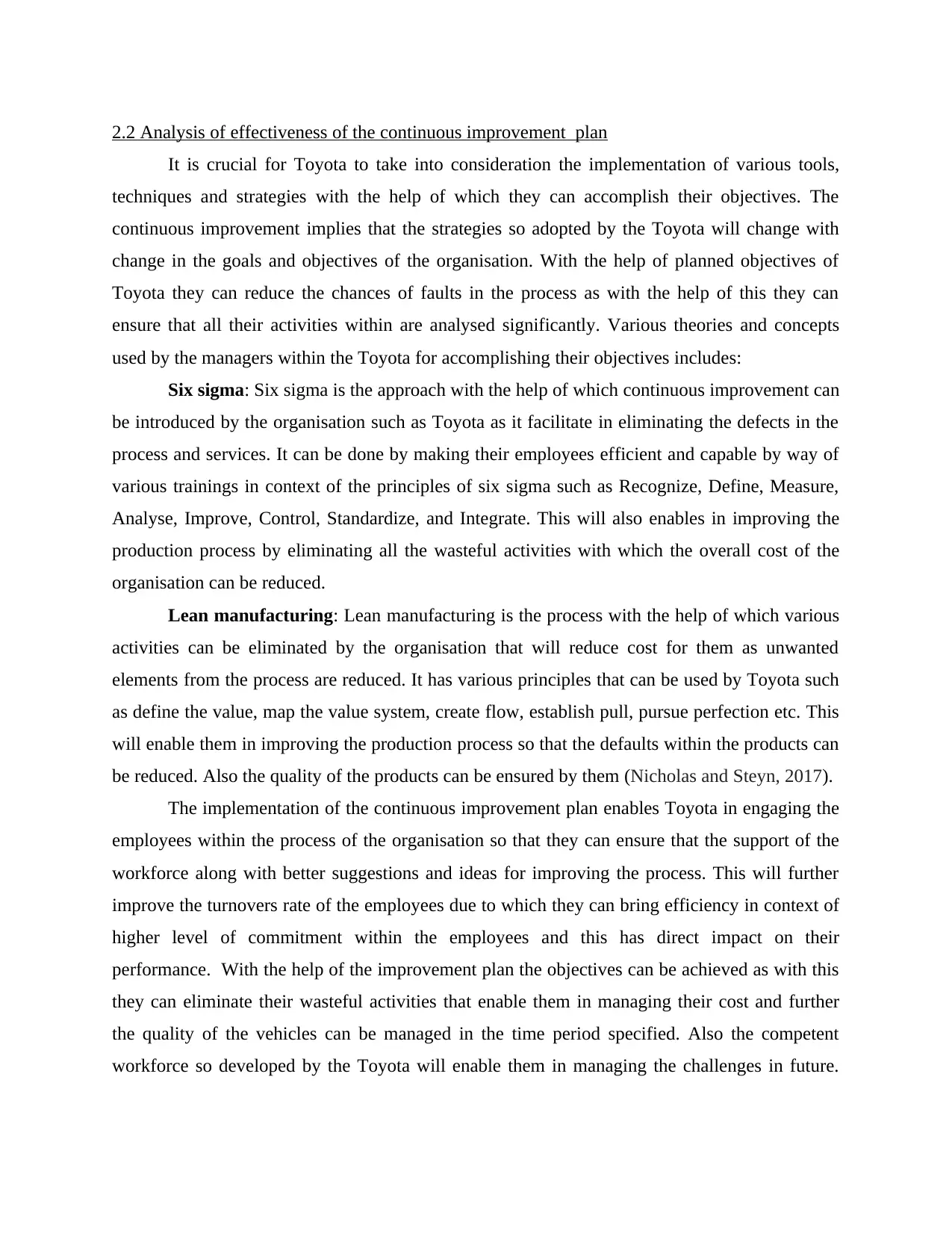
2.2 Analysis of effectiveness of the continuous improvement plan
It is crucial for Toyota to take into consideration the implementation of various tools,
techniques and strategies with the help of which they can accomplish their objectives. The
continuous improvement implies that the strategies so adopted by the Toyota will change with
change in the goals and objectives of the organisation. With the help of planned objectives of
Toyota they can reduce the chances of faults in the process as with the help of this they can
ensure that all their activities within are analysed significantly. Various theories and concepts
used by the managers within the Toyota for accomplishing their objectives includes:
Six sigma: Six sigma is the approach with the help of which continuous improvement can
be introduced by the organisation such as Toyota as it facilitate in eliminating the defects in the
process and services. It can be done by making their employees efficient and capable by way of
various trainings in context of the principles of six sigma such as Recognize, Define, Measure,
Analyse, Improve, Control, Standardize, and Integrate. This will also enables in improving the
production process by eliminating all the wasteful activities with which the overall cost of the
organisation can be reduced.
Lean manufacturing: Lean manufacturing is the process with the help of which various
activities can be eliminated by the organisation that will reduce cost for them as unwanted
elements from the process are reduced. It has various principles that can be used by Toyota such
as define the value, map the value system, create flow, establish pull, pursue perfection etc. This
will enable them in improving the production process so that the defaults within the products can
be reduced. Also the quality of the products can be ensured by them (Nicholas and Steyn, 2017).
The implementation of the continuous improvement plan enables Toyota in engaging the
employees within the process of the organisation so that they can ensure that the support of the
workforce along with better suggestions and ideas for improving the process. This will further
improve the turnovers rate of the employees due to which they can bring efficiency in context of
higher level of commitment within the employees and this has direct impact on their
performance. With the help of the improvement plan the objectives can be achieved as with this
they can eliminate their wasteful activities that enable them in managing their cost and further
the quality of the vehicles can be managed in the time period specified. Also the competent
workforce so developed by the Toyota will enable them in managing the challenges in future.
It is crucial for Toyota to take into consideration the implementation of various tools,
techniques and strategies with the help of which they can accomplish their objectives. The
continuous improvement implies that the strategies so adopted by the Toyota will change with
change in the goals and objectives of the organisation. With the help of planned objectives of
Toyota they can reduce the chances of faults in the process as with the help of this they can
ensure that all their activities within are analysed significantly. Various theories and concepts
used by the managers within the Toyota for accomplishing their objectives includes:
Six sigma: Six sigma is the approach with the help of which continuous improvement can
be introduced by the organisation such as Toyota as it facilitate in eliminating the defects in the
process and services. It can be done by making their employees efficient and capable by way of
various trainings in context of the principles of six sigma such as Recognize, Define, Measure,
Analyse, Improve, Control, Standardize, and Integrate. This will also enables in improving the
production process by eliminating all the wasteful activities with which the overall cost of the
organisation can be reduced.
Lean manufacturing: Lean manufacturing is the process with the help of which various
activities can be eliminated by the organisation that will reduce cost for them as unwanted
elements from the process are reduced. It has various principles that can be used by Toyota such
as define the value, map the value system, create flow, establish pull, pursue perfection etc. This
will enable them in improving the production process so that the defaults within the products can
be reduced. Also the quality of the products can be ensured by them (Nicholas and Steyn, 2017).
The implementation of the continuous improvement plan enables Toyota in engaging the
employees within the process of the organisation so that they can ensure that the support of the
workforce along with better suggestions and ideas for improving the process. This will further
improve the turnovers rate of the employees due to which they can bring efficiency in context of
higher level of commitment within the employees and this has direct impact on their
performance. With the help of the improvement plan the objectives can be achieved as with this
they can eliminate their wasteful activities that enable them in managing their cost and further
the quality of the vehicles can be managed in the time period specified. Also the competent
workforce so developed by the Toyota will enable them in managing the challenges in future.
Paraphrase This Document
Need a fresh take? Get an instant paraphrase of this document with our AI Paraphraser
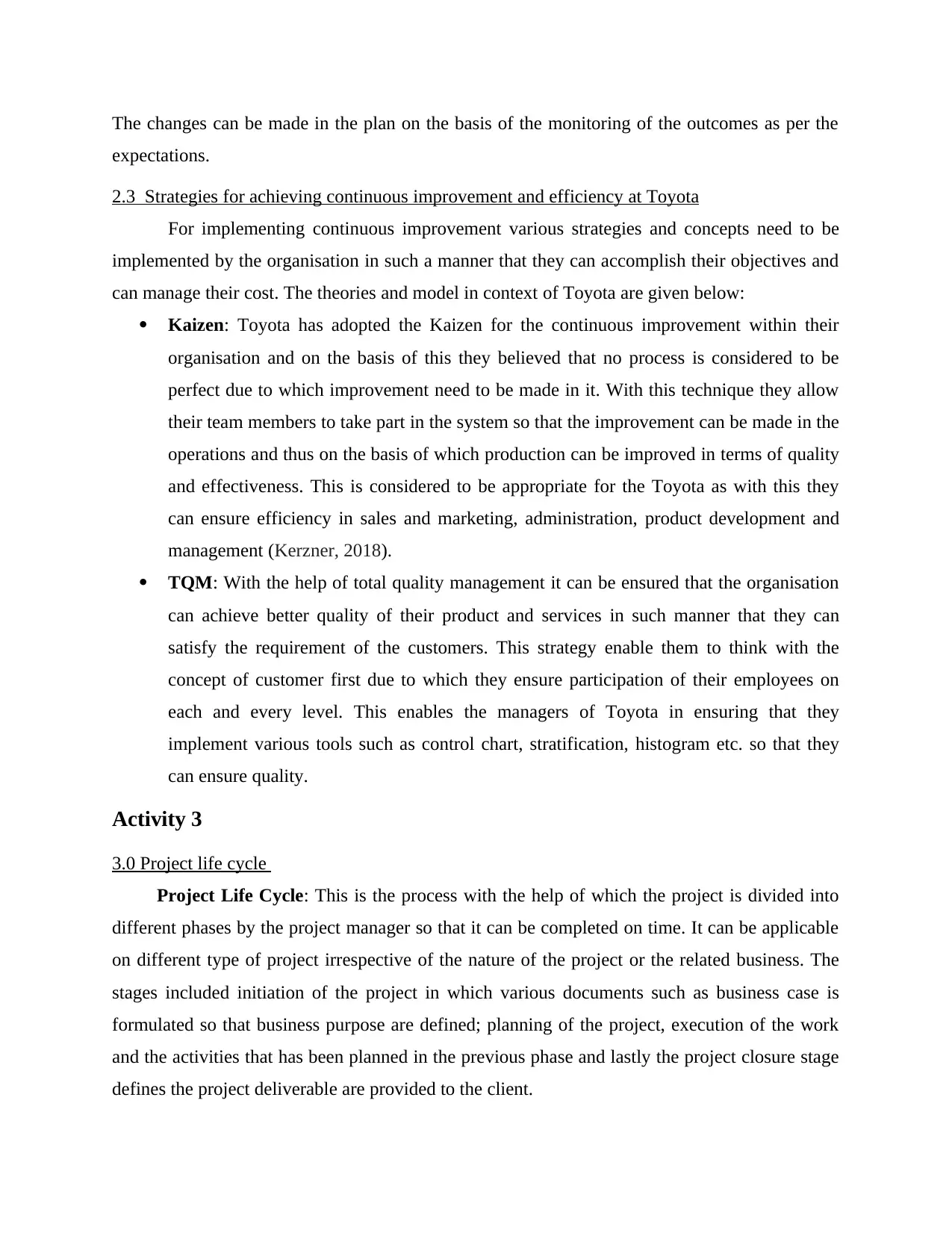
The changes can be made in the plan on the basis of the monitoring of the outcomes as per the
expectations.
2.3 Strategies for achieving continuous improvement and efficiency at Toyota
For implementing continuous improvement various strategies and concepts need to be
implemented by the organisation in such a manner that they can accomplish their objectives and
can manage their cost. The theories and model in context of Toyota are given below:
Kaizen: Toyota has adopted the Kaizen for the continuous improvement within their
organisation and on the basis of this they believed that no process is considered to be
perfect due to which improvement need to be made in it. With this technique they allow
their team members to take part in the system so that the improvement can be made in the
operations and thus on the basis of which production can be improved in terms of quality
and effectiveness. This is considered to be appropriate for the Toyota as with this they
can ensure efficiency in sales and marketing, administration, product development and
management (Kerzner, 2018).
TQM: With the help of total quality management it can be ensured that the organisation
can achieve better quality of their product and services in such manner that they can
satisfy the requirement of the customers. This strategy enable them to think with the
concept of customer first due to which they ensure participation of their employees on
each and every level. This enables the managers of Toyota in ensuring that they
implement various tools such as control chart, stratification, histogram etc. so that they
can ensure quality.
Activity 3
3.0 Project life cycle
Project Life Cycle: This is the process with the help of which the project is divided into
different phases by the project manager so that it can be completed on time. It can be applicable
on different type of project irrespective of the nature of the project or the related business. The
stages included initiation of the project in which various documents such as business case is
formulated so that business purpose are defined; planning of the project, execution of the work
and the activities that has been planned in the previous phase and lastly the project closure stage
defines the project deliverable are provided to the client.
expectations.
2.3 Strategies for achieving continuous improvement and efficiency at Toyota
For implementing continuous improvement various strategies and concepts need to be
implemented by the organisation in such a manner that they can accomplish their objectives and
can manage their cost. The theories and model in context of Toyota are given below:
Kaizen: Toyota has adopted the Kaizen for the continuous improvement within their
organisation and on the basis of this they believed that no process is considered to be
perfect due to which improvement need to be made in it. With this technique they allow
their team members to take part in the system so that the improvement can be made in the
operations and thus on the basis of which production can be improved in terms of quality
and effectiveness. This is considered to be appropriate for the Toyota as with this they
can ensure efficiency in sales and marketing, administration, product development and
management (Kerzner, 2018).
TQM: With the help of total quality management it can be ensured that the organisation
can achieve better quality of their product and services in such manner that they can
satisfy the requirement of the customers. This strategy enable them to think with the
concept of customer first due to which they ensure participation of their employees on
each and every level. This enables the managers of Toyota in ensuring that they
implement various tools such as control chart, stratification, histogram etc. so that they
can ensure quality.
Activity 3
3.0 Project life cycle
Project Life Cycle: This is the process with the help of which the project is divided into
different phases by the project manager so that it can be completed on time. It can be applicable
on different type of project irrespective of the nature of the project or the related business. The
stages included initiation of the project in which various documents such as business case is
formulated so that business purpose are defined; planning of the project, execution of the work
and the activities that has been planned in the previous phase and lastly the project closure stage
defines the project deliverable are provided to the client.
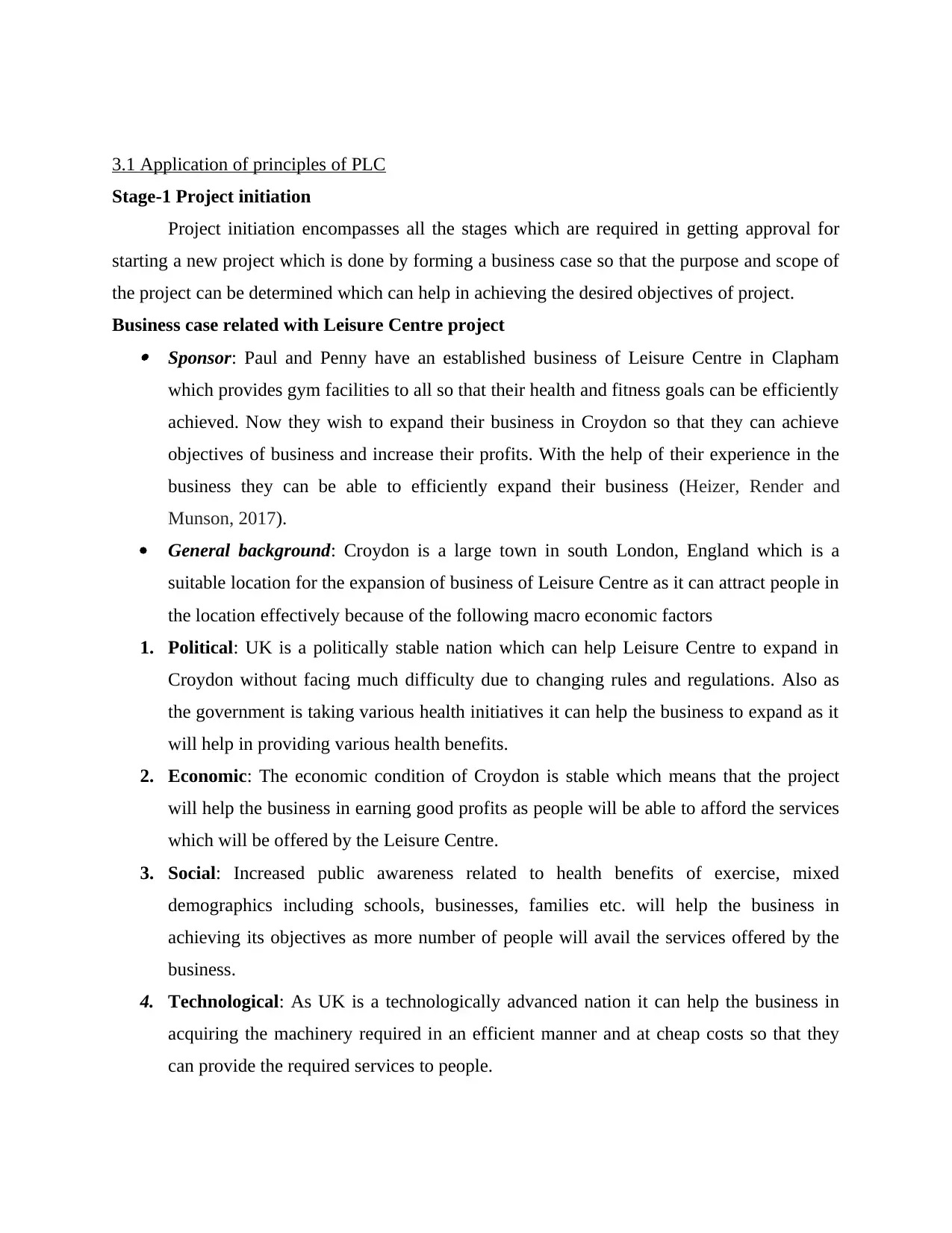
3.1 Application of principles of PLC
Stage-1 Project initiation
Project initiation encompasses all the stages which are required in getting approval for
starting a new project which is done by forming a business case so that the purpose and scope of
the project can be determined which can help in achieving the desired objectives of project.
Business case related with Leisure Centre project Sponsor: Paul and Penny have an established business of Leisure Centre in Clapham
which provides gym facilities to all so that their health and fitness goals can be efficiently
achieved. Now they wish to expand their business in Croydon so that they can achieve
objectives of business and increase their profits. With the help of their experience in the
business they can be able to efficiently expand their business (Heizer, Render and
Munson, 2017).
General background: Croydon is a large town in south London, England which is a
suitable location for the expansion of business of Leisure Centre as it can attract people in
the location effectively because of the following macro economic factors
1. Political: UK is a politically stable nation which can help Leisure Centre to expand in
Croydon without facing much difficulty due to changing rules and regulations. Also as
the government is taking various health initiatives it can help the business to expand as it
will help in providing various health benefits.
2. Economic: The economic condition of Croydon is stable which means that the project
will help the business in earning good profits as people will be able to afford the services
which will be offered by the Leisure Centre.
3. Social: Increased public awareness related to health benefits of exercise, mixed
demographics including schools, businesses, families etc. will help the business in
achieving its objectives as more number of people will avail the services offered by the
business.
4. Technological: As UK is a technologically advanced nation it can help the business in
acquiring the machinery required in an efficient manner and at cheap costs so that they
can provide the required services to people.
Stage-1 Project initiation
Project initiation encompasses all the stages which are required in getting approval for
starting a new project which is done by forming a business case so that the purpose and scope of
the project can be determined which can help in achieving the desired objectives of project.
Business case related with Leisure Centre project Sponsor: Paul and Penny have an established business of Leisure Centre in Clapham
which provides gym facilities to all so that their health and fitness goals can be efficiently
achieved. Now they wish to expand their business in Croydon so that they can achieve
objectives of business and increase their profits. With the help of their experience in the
business they can be able to efficiently expand their business (Heizer, Render and
Munson, 2017).
General background: Croydon is a large town in south London, England which is a
suitable location for the expansion of business of Leisure Centre as it can attract people in
the location effectively because of the following macro economic factors
1. Political: UK is a politically stable nation which can help Leisure Centre to expand in
Croydon without facing much difficulty due to changing rules and regulations. Also as
the government is taking various health initiatives it can help the business to expand as it
will help in providing various health benefits.
2. Economic: The economic condition of Croydon is stable which means that the project
will help the business in earning good profits as people will be able to afford the services
which will be offered by the Leisure Centre.
3. Social: Increased public awareness related to health benefits of exercise, mixed
demographics including schools, businesses, families etc. will help the business in
achieving its objectives as more number of people will avail the services offered by the
business.
4. Technological: As UK is a technologically advanced nation it can help the business in
acquiring the machinery required in an efficient manner and at cheap costs so that they
can provide the required services to people.
⊘ This is a preview!⊘
Do you want full access?
Subscribe today to unlock all pages.

Trusted by 1+ million students worldwide
1 out of 25
Related Documents
Your All-in-One AI-Powered Toolkit for Academic Success.
+13062052269
info@desklib.com
Available 24*7 on WhatsApp / Email
![[object Object]](/_next/static/media/star-bottom.7253800d.svg)
Unlock your academic potential
Copyright © 2020–2025 A2Z Services. All Rights Reserved. Developed and managed by ZUCOL.





